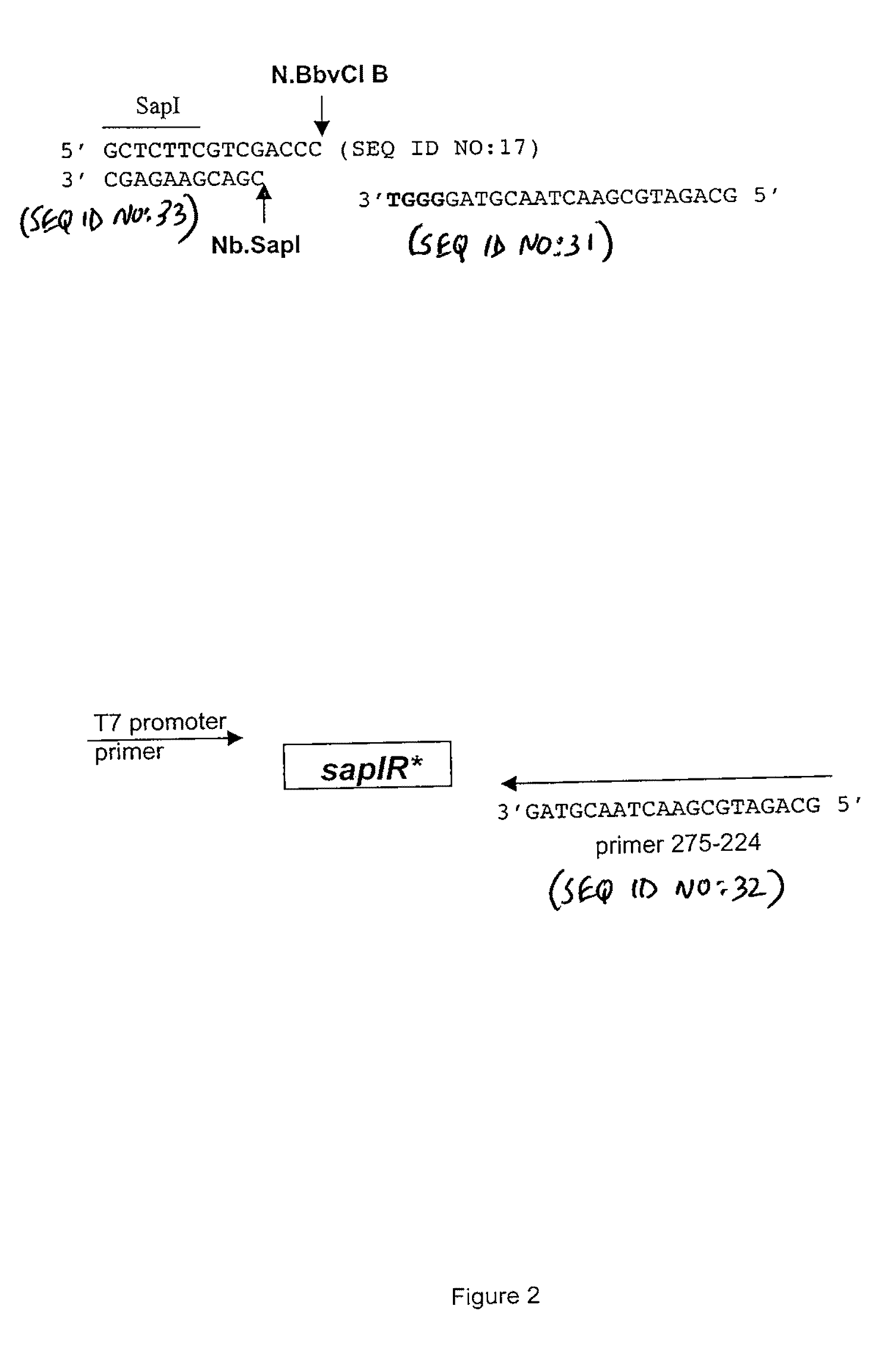Method for engineering strand-specific nicking endonucleases from restriction endonucleases
a technology of restriction endonucleases and endonucleases, which is applied in the field of engineering strand-specific nicking endonucleases from restriction endonucleases, can solve the problems of limited application of such mutants in dna manipulation and limited approach to type iit enzymes, and achieve the effect of enhancing the efficiency of obtaining nicking endonucleases
- Summary
- Abstract
- Description
- Claims
- Application Information
AI Technical Summary
Benefits of technology
Problems solved by technology
Method used
Image
Examples
example 1
Engineering Strand-Specific Nicking Enzyme Nb.SapI from SapI Restriction Endonuclease
1. Design and Construction of Expression Vector Containing Strategically Located SapI Site.
[0100]The polylinker of expression vector pACYCT7-ter (Xu et al. Mol. Gen. Genet. 260:226-231 (1998)) was modified to contain a SapI site. Two complementary phosphorylated oligonucleotides (25 mers) were PAGE-purified, annealed and ligated into the BamHI site of pACYCT7-ter. Proper insertion created one BamHI site followed by the sites for SapI, SalI and BbvCI (see FIG. 1). The modified polylinker was confirmed by sequencing with the T7 universal primer from NEB product #S1248S, New England Biolabs, Inc., Beverly, Mass. The modified vector was named pSAPV6.
[0101]
5′ P-GATCCGCTCTTCGTCGACCCTCAGC 3′(SEQ ID NO: 1)top of polylinker insert (296-332)5′ P-GATCGCTGAGGGTCGACGAAGAGCG 3′(SEQ ID NO: 2)bottom of polylinker insert(296-333)
2. Error-Prone PCR Mutagenesis of the sapIR Gene and Isolation of Mutant Plasmid Librari...
example 2
Engineering Top Strand-Specific Nicking Enzyme Nt.SapI from SapI Restriction Endonuclease
[0122]The failure to immediately isolate a top-strand nicking variant was most likely due to the limited size of the initial library (only 120 clones). Furthermore, it was later determined that genetic selection in ER1992 was not stringent enough to adequately eliminate variants with double-stranded cleavage activity. In the case of a rare-cutting enzyme, (i.e SapI) it was advantageous to perform the genetic selection step with a strain encoding the T7 RNA polymerase to increase constitutive SapI expression from pSAPV6.
1. Isolation of Mutant Plasmid Library by Genetic Selection in ER2848.
[0123]The same mutagenized sapIR gene described in Example 1 was ligated into pSAPV6 and transformed into ER2848 by electroporation. The transformation mix was plated on LB agar plus Cam and incubated overnight at 30° C. and 37° C. There was no difference in colony number at the two incubation temperatures. Appr...
PUM
| Property | Measurement | Unit |
|---|---|---|
| temperature | aaaaa | aaaaa |
| concentration | aaaaa | aaaaa |
| temperature | aaaaa | aaaaa |
Abstract
Description
Claims
Application Information
 Login to View More
Login to View More - R&D
- Intellectual Property
- Life Sciences
- Materials
- Tech Scout
- Unparalleled Data Quality
- Higher Quality Content
- 60% Fewer Hallucinations
Browse by: Latest US Patents, China's latest patents, Technical Efficacy Thesaurus, Application Domain, Technology Topic, Popular Technical Reports.
© 2025 PatSnap. All rights reserved.Legal|Privacy policy|Modern Slavery Act Transparency Statement|Sitemap|About US| Contact US: help@patsnap.com



